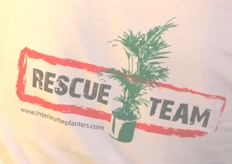
In Northern Europe, palm trees do not grow naturally. When cultivating palms is such conditions, a number of things must therefore be taken into account. But even with those precautions, something can still go wrong. This manual explains the main issues and remedies.
Brown or dried leaf tips
One of the most common symptoms but which can have many causes. First of all, it is necessary to check whether all the natural needs of your palm species are met: water, light, humidity and temperature. For a detailed explanation of the general care of palms, please take a look at this page: palm trees care.
If the problem is not the wrong care, it may be due to one of the following causes:
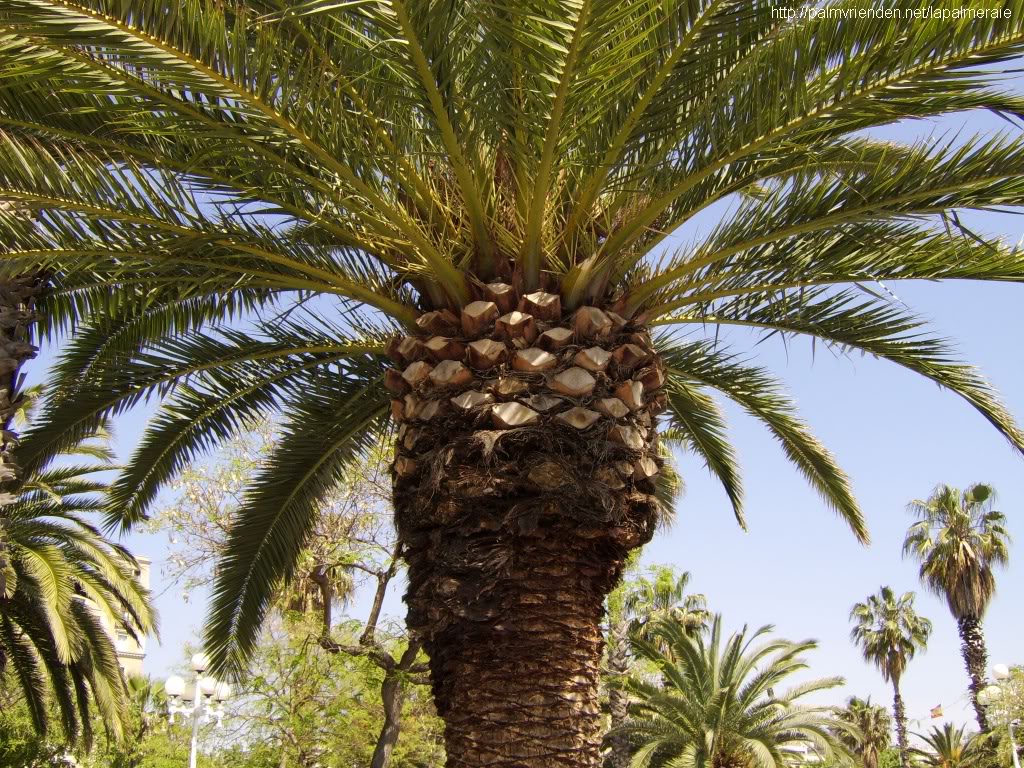 Pest? See further below
Pest? See further below
Frost damage? See further below
Growth? When only the lower leaves dry out, but the other, newer leaves and spear still look good, you don’t have to worry, this is part of the natural growth process. Once the lower leaves have completely dried out, remove them.
Brown ‘rusty’ stains on the leaves
 Rusty colored stains are visible on the leaves, often the finer leaflets. This indicates sunburn. Check the location of your palm and move the palm if necessary. Palm seedlings and palms that have been indoors for a longer period of time (including those from garden centres!) must slowly get used to the sun. In other words, the number of hours of direct sunshine must be gradually increased. The places that have already been burned do not recover.
Rusty colored stains are visible on the leaves, often the finer leaflets. This indicates sunburn. Check the location of your palm and move the palm if necessary. Palm seedlings and palms that have been indoors for a longer period of time (including those from garden centres!) must slowly get used to the sun. In other words, the number of hours of direct sunshine must be gradually increased. The places that have already been burned do not recover.
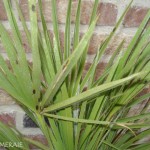 Black / brown dots on the leaves
Black / brown dots on the leaves
These stains indicate root damage. The soil is often too wet. Check the correct needs of your palm and adjust the conditions accordingly. This condition often occurs after the winter months when it was logically far more humid for several months. Always ensure proper drainage to prevent root rot.
Leaves turn yellow
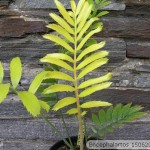 This discoloration may indicate a lack of nutrition and in particular a lack of iron. The application of special palm fertilizer gives the plant all the necessary nutrients. In extreme cases iron chelate can also be used which specifically addresses iron deficiency. Use liquid fertilizer for quicker action or a pellets for a more natural and longer lasting effect.
This discoloration may indicate a lack of nutrition and in particular a lack of iron. The application of special palm fertilizer gives the plant all the necessary nutrients. In extreme cases iron chelate can also be used which specifically addresses iron deficiency. Use liquid fertilizer for quicker action or a pellets for a more natural and longer lasting effect.
Winter / frost damage
Palms that have suffered from too cold temperatures (frost) show dark green striping in the leaves. These are the first signs of leaf damage. When the leaf freezes too far, these strips turn into brown/yellow spots afterwards. In extreme conditions, even the whole leaf crown can dry out.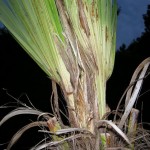 To check if the palm is still alive, gently pull the spear. If it is still tightly attached, the palm will survive, even though it will take some time before the palm has a new beautiful crown of leaves. If you can pull the spear (spear rot) the palm is basically dead.
To check if the palm is still alive, gently pull the spear. If it is still tightly attached, the palm will survive, even though it will take some time before the palm has a new beautiful crown of leaves. If you can pull the spear (spear rot) the palm is basically dead.
You can however still try 2 things. First you can fill the gaping hole in the heart of the palm with a Bordeaux mixture to prevent further rotting. Cover to hole from rain.
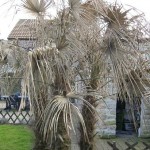 This will counteract the spear rot. You can also cut the trunk down to the solid part, slice by slice so that the rotten part is removed.
This will counteract the spear rot. You can also cut the trunk down to the solid part, slice by slice so that the rotten part is removed.
Also see How to treat spear rot
Leaves dry out
When the leaves dry out, and this could not be due to:
- winter damage
- sunburn
- pest
- the root ball / soil is too moist
- the roots are clay potted
- fungal infection (fusarium)
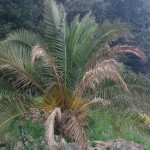
Also see: Phoenix roebelenii: why the leaves are dry?
PESTS
Aphid or Plant lice
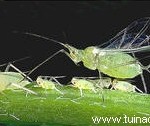 The aphid is not always immediately noticeable, but is easy to recognize during more thorough inspection. These insects of half a millimeter are usually green, but sometimes also black or red. They are located on the youngest parts of the plant and propagate quickly, so you will soon have to deal with a real plague. Small numbers can be manually removed. However, this will no longer suffice in the case of larger numbers. The natural enemy of the aphid is the ladybug. But using them as control agents is only effective in a small and closed area like a greenhouse. The plants can also be treated with a solution of water and green soap. You can also make a solution of water with a some of tobacco. After a night soaking, pour the product into the potting soil. The plant will incorporate this solution in the sap flow and thus remove the aphids itself. Eventually you can also opt for a standard pesticide. There is a large range of both chemical and biological products against aphids.
The aphid is not always immediately noticeable, but is easy to recognize during more thorough inspection. These insects of half a millimeter are usually green, but sometimes also black or red. They are located on the youngest parts of the plant and propagate quickly, so you will soon have to deal with a real plague. Small numbers can be manually removed. However, this will no longer suffice in the case of larger numbers. The natural enemy of the aphid is the ladybug. But using them as control agents is only effective in a small and closed area like a greenhouse. The plants can also be treated with a solution of water and green soap. You can also make a solution of water with a some of tobacco. After a night soaking, pour the product into the potting soil. The plant will incorporate this solution in the sap flow and thus remove the aphids itself. Eventually you can also opt for a standard pesticide. There is a large range of both chemical and biological products against aphids.
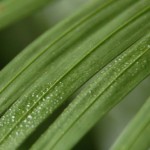 Scale insect
Scale insect
These small brown to black insects with a flat scale shield hardly stands out because they are immobile on the plant. They stick to protect their vulnerable base. The sticky separation (honeydew) that occurs on the leaves is more striking. The palm is suffering a lot from the suction damage. Scale insects are note caused by a wrong care but occur mainly by coincidence. Small numbers can be removed manually.
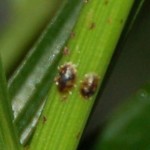 If necessary, they can be tipped with a cotton swab soaked in spirit. Or the plant can be sprayed with a solution of soap and spirit (mix 2 tablespoons spiritus, 2 tablespoons of green soap and put them in the sprayer), thanks to their shield they are relatively resistant to regular products. So choose a product that is specially designed to treat scale insects which often containing effective oils. Pesticides that are absorbed by the sap flow are also effective. Preventive measures can be taken to mix some tobacco in the top layer of the potting soil. This will be included in the sap flow when watering and will thus repel the insects. Pills are also sold that are placed in the potting soil for prevention. This preventive approach also works through inclusion in the sap flow but isn’t effective enough for treatment once already infected.
If necessary, they can be tipped with a cotton swab soaked in spirit. Or the plant can be sprayed with a solution of soap and spirit (mix 2 tablespoons spiritus, 2 tablespoons of green soap and put them in the sprayer), thanks to their shield they are relatively resistant to regular products. So choose a product that is specially designed to treat scale insects which often containing effective oils. Pesticides that are absorbed by the sap flow are also effective. Preventive measures can be taken to mix some tobacco in the top layer of the potting soil. This will be included in the sap flow when watering and will thus repel the insects. Pills are also sold that are placed in the potting soil for prevention. This preventive approach also works through inclusion in the sap flow but isn’t effective enough for treatment once already infected.
Mealybug
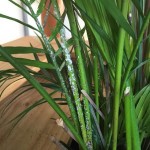 Mealybug can be recognized immediately as small groups of white fluff, almost similar to mold. This is one of the most stubborn pests for the plant that can hardly be removed. When you see these insects at the time of purchase, you better avoid the plant. Infected plants are also best removed from other healthy plants. Treatment is absolutely necessary where only a strong product will have the intended effect. Repeated treatment is certainly necessary to eradicate future generations. Thoroughly treat all parts of the plant. Each garden centre offers suitable products.
Mealybug can be recognized immediately as small groups of white fluff, almost similar to mold. This is one of the most stubborn pests for the plant that can hardly be removed. When you see these insects at the time of purchase, you better avoid the plant. Infected plants are also best removed from other healthy plants. Treatment is absolutely necessary where only a strong product will have the intended effect. Repeated treatment is certainly necessary to eradicate future generations. Thoroughly treat all parts of the plant. Each garden centre offers suitable products.
Spider mite
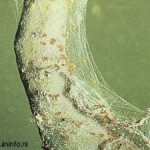 These very small red or white spiders, the size of a pin button, are difficult to see with the naked eye. But the palm itself clearly shows that there is something wrong. Usually it starts with silver-colored speckles on the leaves. Eventually the leaves become dry and withered. Wooly spider webs can be found on the petioles. In general, spider mite indicates that the location has a humidity that is too dry. This is why they generally occur in palms kept indoors. During the winter months, the central heating system ensures low humidity. To compensate for this, you can regularly spray the leaves with a plant sprayer. A summer rain shower will also be a virtue for the palm. Spider mite forms a persistent pest. Spraying alone will not always be enough. The best way to remove contaminated plant parts is to remove them. You can also chemically fight the spider mite.
These very small red or white spiders, the size of a pin button, are difficult to see with the naked eye. But the palm itself clearly shows that there is something wrong. Usually it starts with silver-colored speckles on the leaves. Eventually the leaves become dry and withered. Wooly spider webs can be found on the petioles. In general, spider mite indicates that the location has a humidity that is too dry. This is why they generally occur in palms kept indoors. During the winter months, the central heating system ensures low humidity. To compensate for this, you can regularly spray the leaves with a plant sprayer. A summer rain shower will also be a virtue for the palm. Spider mite forms a persistent pest. Spraying alone will not always be enough. The best way to remove contaminated plant parts is to remove them. You can also chemically fight the spider mite.
Palm butterfly (Paysandisia)
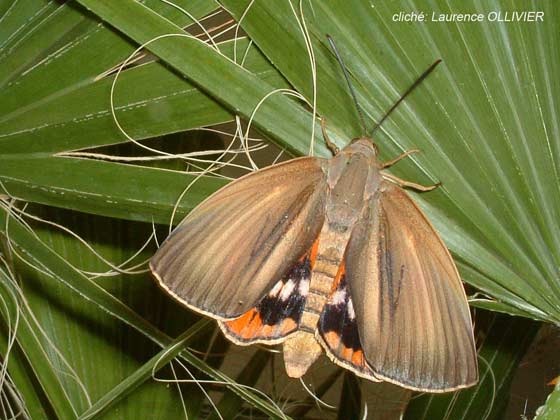 This moth, called the Paysandisia archon, was introduced in Europe by the importation of palms from South America. Its originates from Argentina. In Europe, for the time being it is only spotted in southern regions (France, Italy, Spain, Portugal,…) Luckily it is not a great traveler but palms that are close to the infected palm certainly form a potential host. The eggs in the size of a grain of rice are laid in the petioles by the moth that can grow about 11cm in size.
This moth, called the Paysandisia archon, was introduced in Europe by the importation of palms from South America. Its originates from Argentina. In Europe, for the time being it is only spotted in southern regions (France, Italy, Spain, Portugal,…) Luckily it is not a great traveler but palms that are close to the infected palm certainly form a potential host. The eggs in the size of a grain of rice are laid in the petioles by the moth that can grow about 11cm in size.
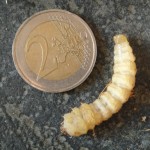 Because the hairy trunk makes it easier for eggs to be deposited, Trachycarus and Chamaeropses are the main victims of this insect. The larvae can reach a length of 8cm. They eat their way through the palm, making holes in the trunk visible. The leaf also shows a typical damage of the gnawing. At the base of the palm and on the trunk there is also a kind of sawdust, the material formed and rejected by the gnawing larva. When the contamination is too advanced, the palm will have to be destroyed by the complete combustion of the palm.
Because the hairy trunk makes it easier for eggs to be deposited, Trachycarus and Chamaeropses are the main victims of this insect. The larvae can reach a length of 8cm. They eat their way through the palm, making holes in the trunk visible. The leaf also shows a typical damage of the gnawing. At the base of the palm and on the trunk there is also a kind of sawdust, the material formed and rejected by the gnawing larva. When the contamination is too advanced, the palm will have to be destroyed by the complete combustion of the palm. 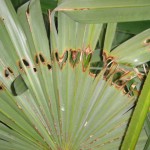
Red palm weevil
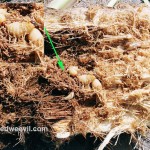
Originally from India, the Rhynchophorus ferrugineus caused a great deal of damage in the Middle East in the early 20th century. Meanwhile, there have also been cases in Spain and southern France. All stages of this pest, egg, larva and pupa are spent inside the palm. The female lays up to 300 eggs in a wound or cavity of the palm. After 2 days the larva comes out of the egg that eats its way right through palm for 1 to 3 months. Chemical control comes often too late in many cases. In that case, the only solution to prevent further contamination is to remove and burn the palm.
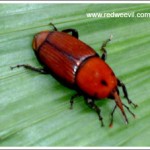
Please refer to this article for a complete description: The palm moth & Red Palm Weevil: everything you need to know!
Caterpillar
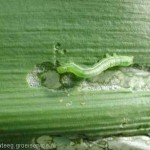 In general, palms are not so often affected by gnawing. The stiff leaf will be partly responsible for this. Young seedlings sometimes become a caterpillar victim however. The traces of gnawing are easy to recognize due to large irregular pieces of the leaves being cut. Sometimes the caterpillar is already nestled in the cocoon. The leaf segments are then glued together with its webbing. When you see traces of gnawing, check the whole plant for the presence of caterpillars. Simply remove the caterpillars by hand. Also the caterpillars that are already nestled in the cocoon. This problem is hardly ever widespread and therefore there is no need for further control.
In general, palms are not so often affected by gnawing. The stiff leaf will be partly responsible for this. Young seedlings sometimes become a caterpillar victim however. The traces of gnawing are easy to recognize due to large irregular pieces of the leaves being cut. Sometimes the caterpillar is already nestled in the cocoon. The leaf segments are then glued together with its webbing. When you see traces of gnawing, check the whole plant for the presence of caterpillars. Simply remove the caterpillars by hand. Also the caterpillars that are already nestled in the cocoon. This problem is hardly ever widespread and therefore there is no need for further control.
Cat
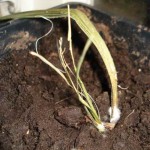 The fact that cats and palm seedlings are not a good combination has been proven many times. Cats like to chew on grassy plants for the hairballs to run out. This damage is recognizable by the winky remains that remain after chewing. If the cat has also broken the spear or the small stem, the seedling can no longer be saved. Only preventive measures can help to tackle this, such as removing or protecting the seedling. Putting the pot in a big glass jar can be a simple and aesthetic solution.
The fact that cats and palm seedlings are not a good combination has been proven many times. Cats like to chew on grassy plants for the hairballs to run out. This damage is recognizable by the winky remains that remain after chewing. If the cat has also broken the spear or the small stem, the seedling can no longer be saved. Only preventive measures can help to tackle this, such as removing or protecting the seedling. Putting the pot in a big glass jar can be a simple and aesthetic solution.
OTHER INSECTS
Springtails
We regularly receive the question what can be done against the small white insects in the potting soil. However, these springtails are not harmful to the plant at all. On the opposite, they live on fungi and thus prevent the formation of mold on the potting soil. They are therefore very much appreciated in the seed trays kept on high temperatures and high humidity will otherwise quickly mold.
Dark-winged fungus gnats
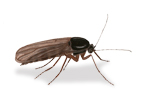 This little fly, closely resembling the fruit fly but slightly smaller lays its eggs in moist soil. The flies are not so much harmful as annoying. They propagate very quickly, which make you find these flies about everywhere in the house quite quickly. However, the larvae can be harmful to weaker plants. To combat the flies, yellow catch strips can be placed in the potting soil. The flies are attracted by this and then will stick to the strip. The vacuum cleaner can also be used to suck up all flies. When knocking against the pot, most flies usually will fly up from the ground. Make use of this to catch as much as possible. If this is repeated daily during one week, the problem will largely be resolved. The potting soil can also be poured with a extract of tobacco. This is harmless to the plant but kills the larvae. Eventually you can also use an effective chemical control.
This little fly, closely resembling the fruit fly but slightly smaller lays its eggs in moist soil. The flies are not so much harmful as annoying. They propagate very quickly, which make you find these flies about everywhere in the house quite quickly. However, the larvae can be harmful to weaker plants. To combat the flies, yellow catch strips can be placed in the potting soil. The flies are attracted by this and then will stick to the strip. The vacuum cleaner can also be used to suck up all flies. When knocking against the pot, most flies usually will fly up from the ground. Make use of this to catch as much as possible. If this is repeated daily during one week, the problem will largely be resolved. The potting soil can also be poured with a extract of tobacco. This is harmless to the plant but kills the larvae. Eventually you can also use an effective chemical control.
Of course, this is not an exhaustive list of all possible diseases and pests. The phenomena discussed are the most common. If there is a disease or plague that you would like to add in the list, please let us know!
© La Palmeraie




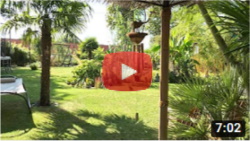








Reactie door michael lonergan — 12 oktober 2020 16:58 @ 16:58
the sprouting palm leaves have died off and there is no regrowth please help
Reactie door lapalmeraie — 13 oktober 2020 08:17 @ 08:17
Hi Michael
What kind of palm species are you talking about and in what conditions do you keep it? This to understand a bit better your situation and try to figure out what kind of issues you may encounter down under, which should be at least a bit different then mine here up North.
Kind regards
La Palmeraie
Reactie door Wero — 14 februari 2021 02:40 @ 02:40
Helo!
I’m an owner of 2 ruffled palm
Trees (Licuala). I live in Sri Lanka south coast. It’s dry season now but it has been quite rainy (once a week we have a tropical rain). Both palms Have problems, different in my opinion as the color of the diying leafs are different :/ I looked through internet to find some guidelines but so far nothing matching my problems or explaining different browning of leafs. And since it’s a small village it’s really hard to get a professional gardener help here.
You’ll find description and photos attached!
please help!
1. The palm in a bag
This palm bought already this size about a month ago from a local man. It was all green. At that time I was staying really close to the sea by the beach so he warned me that this kind of pan doesn’t like very salty air, and I should spray leafs once in a while to clean the salt (so I did).
It was doing well for 2 weeks. Staying in the bright spot but not with the direct sunlight. I check the soil and water it when it dries out. Sometimes it was heavy raining so then I checked the soil properly drain the water out from the bag (bag has holes). I didn’t put it in the pot or soil because I’m a new I’m gonna move to another spot. After two weeks this browning of bottom
Leafs started. Already 4 leafs in one week! They are not super dry, just brown and bit drying.The plant is still growing new ones but please help me so it doesn’t die! No I’m in the new spot not that close to the sea so the air is for sure less salty.
Is it not enough sun? Or too much humidity (could be bc if heavy rains but to be honest ppl
Have thouse pals here and half year is a wet season and it’s raining a LOT)
2. 2nd palm was growing already in the garden of the house I rented. The leaves are also browning but in a different way – more dry than the other palm and the color is much lighter. It’s again in a partly shaded spot – There is a lot of coconut palms around so it’s really hard to get a pure direct sun spot so I’m sure it’s not bc if too much sun.
https://ibb.co/mhGBQpr
https://ibb.co/d6nJdPy
https://ibb.co/5h7m3vB
https://ibb.co/rQnrrgm
https://ibb.co/vBgzY3T
https://ibb.co/ZSpRzwB
Reactie door lapalmeraie — 15 februari 2021 08:35 @ 08:35
Hi!
My first question from Sri Lanka and I am very happy to help you try to explain these problems.To start you should know that the Licuala isn’t the easiest palm species to begin with. It needs very high air humidity, heath and shade. In its natural habitat it grows as under growth beneath big trees. The dry parts on the fronts of the Licuala planted in the garden should therefore be due to sunburn. The brown leaves on your potted palm is due to an inappropriate recipient and all the recent changes, transport etc. The bag holds too much moisture and you can see how the bottom half is completely soaked. Its lack of support could damage the fragile roots even further. I would suggest that you plant it in a container. This shouldn’t be any way different for the moving than the bag I guess? This way the roots can recover and the soil should have a better drainage. The heavy rains are even welcome for this palm so instead of moisturizing the fronts just place it briefly in the rain when it doesn’t rain too heavily.
Kind regards
La Palmeraie
Reactie door Wetzel — 16 februari 2022 17:10 @ 17:10
My Phoenix palm trees are dying. The gardener says they have a worm in the trunk. They are 2 stories in height. They are my only shade in the summer. I must save them. They are only 10+ years old. Help!
Reactie door lapalmeraie — 17 februari 2022 08:44 @ 08:44
Hi Wetzel
I would advise you to read my article about the palm butterfly and the red palm weevil, both are highly present in your region and especially the weevil created great damage on entire Phoenix populations in Southern France. Compare the symptoms to your palms in order to determine whether they are indeed infected and if so, which one of the parasites and which stadium. Now I have to say that the Phoenix is known for hiding its infection for a very long time and therefore the symptoms are frequently only discovered when it’s already too late.
http://palmvrienden.net/gblapalmeraie/2017/10/19/the-palm-moth-red-palm-weevil-everything-you-need-to-know/
Kind regards
La Palmeraie
Reactie door Kathleen — 14 maart 2022 09:57 @ 09:57
https://ibb.co/vdyJrHC
https://ibb.co/q9CyS7s
https://ibb.co/h2qd4GR
My palm is dying! I just planted it two weeks ago and it is already doing so poorly. Looks like some of the issue is sunburn but I am not sure. The ends of the leaves are dark brown and curled. Is this from sunburn or not enough water? I want to save this palm as it was expensive. If it is from sunburn I can set up a shade over it until it gets used to the sun. If it is water I can adjust. How can I save this tree? Thank you!!
Reactie door lapalmeraie — 14 maart 2022 19:16 @ 19:16
Hi Kathleen
The light brown shine on the fronts looks to sunburn indeed. You can put a shade cloth above but I do expect it to worsen anyway. You might probably even loose all the burned fronts. This doesn’t mean however that the palm is dead. It will continue to grow but will have to grow a complete new crown which may take some time. The seller should have warn you to avoid this unpleasant start. The dark brown dried petioles are dead leaf ends. Maybe the wind made them hit the fence repeatedly and damaged them for which they died off early.
So for now you can’t really do anything then be patient. Your palm will most probably loose a major part of its leaves but will continue to grow. Make sure that the soil remains moist but not soaked wet.
Kind regards
La Palmeraie
Reactie door www.hindustantimes.com — 30 januari 2023 10:55 @ 10:55
Just letting you know that I reckon someone has hacked your site because it is painfully slow on my
computer
Reactie door Dale — 22 mei 2023 21:17 @ 21:17
Hi,
We live in the UK and bought a Trachycarpus Palm Tree from a local shop about 6 days ago, this evening we noticed the tips were turning brown so we decided to give a bit more water. However I had a close look at the leaves and I noticed some seem split or have holes in them? It’s hard to describe so I have uploaded some pictures here.
We came across your site through a google search and it seems a great wealth of information, any advice would be gratefully appreciated.
https://ibb.co/v4TBcDK
https://ibb.co/j887FLn
https://ibb.co/rMXWxR3
https://ibb.co/QMMKG23
https://ibb.co/T2BvSfS
Reactie door lapalmeraie — 22 mei 2023 21:25 @ 21:25
Hi Dale
Those brown spots and splitted areas are winter damage imho. So definitely not a wrong treatment on your side in those few days. Problems always show up much later due to the slow growth of palm trees. Only in one of the pictures I see real holes, which looks like something ate its way through. Inspect the palm tree carefully in order to see if this unwanted guest is still there or not. Otherwise I don’t see any problems concerning the brown splitted areas, over time, new healthy leaves should appear.
Kind regards
La Palmeraie
Reactie door Dale — 22 mei 2023 21:42 @ 21:42
Thank you so much for your reply, we were getting really worried after reading about the Pests on your page and starting to panic as we both thought none of these brown spots and split areas were there when we bought it, but we may be wrong.
What would the unwanted guests look like or their eggs? We are not familiar with this plant as it is our first palm so any help with what signs to look like would be really appreciated. I can take some more pictures of the soil tomorrow and upload them.
I cannot thank you enough for replying to us, especially so quickly.
Dale
Reactie door lapalmeraie — 23 mei 2023 07:13 @ 07:13
Hi Dale
It’s my pleasure.
There aren’t that many pests and diseases for palm trees to be honest. Only in southern Europe they struggle with the palm moth and the red palm weevil which causes tremendous amounts of damaged and even deceased palm trees. In northern Europe and in the UK we do not have those threats. Not due to our climate but due to the fact that the palm trees are too scarce and therefore these pests do not find enough places to reproduce and spread. You can check the symptomes with the info from this article but I’m quite sure that it isn’t what is happening with your palm (even if it has most probably been imported from southern Europe). http://palmvrienden.net/gblapalmeraie/2017/10/19/the-palm-moth-red-palm-weevil-everything-you-need-to-know/
You keep in mind that almost all plants deteriorate a bit after being planted. I even dedicated an article to that: http://palmvrienden.net/gblapalmeraie/2017/10/13/why-does-my-palm-tree-degrades-after-planting/
You may always share some more pictures of the palm and if possible also pictures where I can see the whole palm tree and its environment to have a better idea.
Kind regards
La Palmeraie
Reactie door Martina Schwarz — 14 oktober 2023 15:32 @ 15:32
Hi, I am so glad to have found your site, maybe you can help me.
We have a King Palm for 11 years and since autumn last year the new leaves have dried up shortly after they grew.
At first I thought it was because of my watering, but the last ones only grew to about 20 cm and came out dried up, brown-black and like paper. Unfortunately I had already cut them off before I took the pics.
I am afraid that it is a fungus or virus that is transferred to the new leaves through contact. I can’t dig up the palm to look at the roots, but if it has something to do with the roots, the old leaves would probably have died too. Is there anything I can do?
Many thanks in advance
Martina
https://ibb.co/4PQ9g18
https://ibb.co/DMWXW8R
https://ibb.co/4jHPmqM
Reactie door lapalmeraie — 16 oktober 2023 13:44 @ 13:44
Hello Martina Schwarz
Very strange indeed. I do not recognize any “classical” diseases and do not believe that some kind of fungus is to be caused. It would indeed infect the older leaves first.
As the dried leaves are not longer there it’s impossible to see any other symptoms that could explain the leaves drying like this. Are you sure that they are not attacked by insects or reptiles? I know from some other exotic areas that iguanas do a lot of damage to young leaves.
Otherwise I found this interesting page but still I do not see any of these diseases that look likes what happening with your palm; https://www.backyardgardener.com/plantname/archontophoenix-alexandrae-northern-bangalow-palm/
Kind regards
La Palmeraie
Reactie door Martina — 17 oktober 2023 05:56 @ 05:56
Thank you for the quick answer and the link. I have uploaded 2 pictures where you can still see some of the leaves in the middle, but the white dots came later. Maybe it will sprout another leaf, but it doesn’t look like it at the moment. I will now fertilise it and also spray a fungicide prophylactically, wait and hope, but unfortunately the palm will probably die.
Regards
Martina
https://ibb.co/5KXdGc1
https://ibb.co/q1t54g5
Reactie door lapalmeraie — 17 oktober 2023 06:44 @ 06:44
Hi Martina
This is fungus indeed but it is on dead organic material so that is quite logical. When the palm suffers from for instance fusarium, all the leaves would be concerned and always starting from the base. It’s a good idea to apply some fungicide into the heart of the palm but if possible, use it non diluted as poudre. This way you can keep the heart of the palm as dry as possible.
Kind regards
La Palmeraie